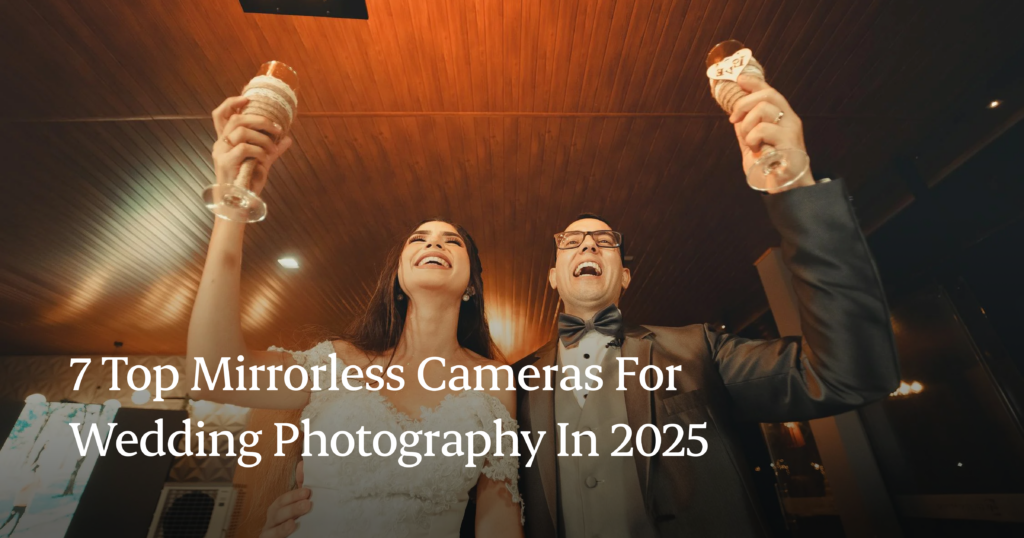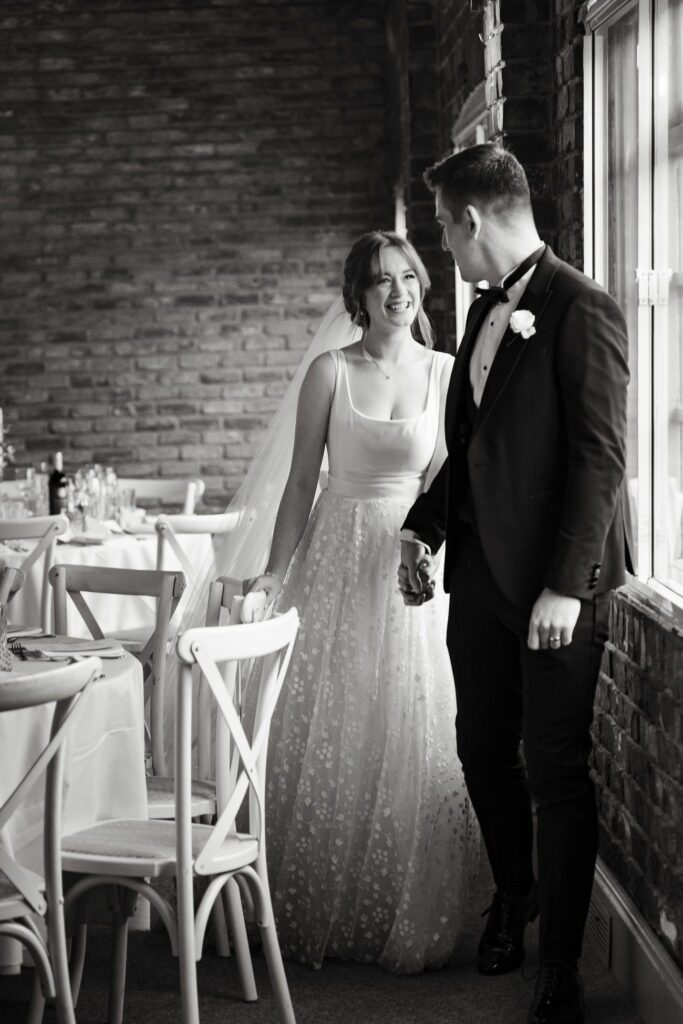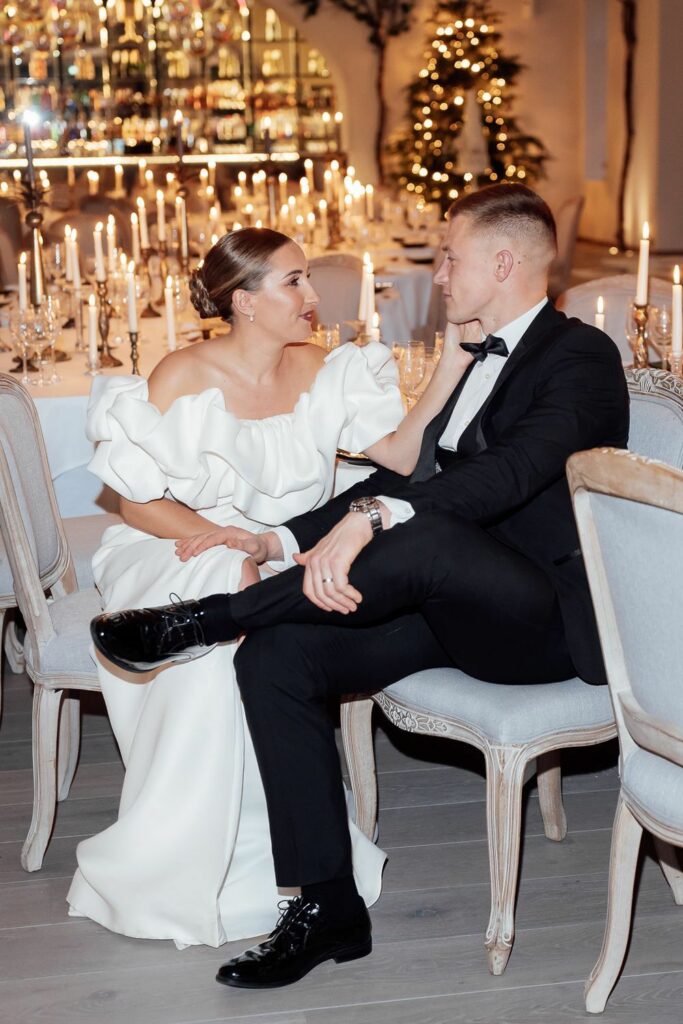7 Top Mirrorless Cameras for Wedding Photography in 2025
Mirrorless cameras have become the go-to for professional wedding photographers. These modern cameras are fast, lightweight, and built for real-world conditions.
Features like silent shooting mode, in-body image stabilization, and fast and accurate autofocus help you capture stunning images throughout the wedding day, from fast-moving reception moments to intimate portraits.

While some photographers still swear by their DSLR cameras, especially for battery life and durability, most agree that mirrorless cameras offer clear advantages for wedding photography, particularly when it comes to speed, portability, and low-light performance.
To help you find the best mirrorless camera for wedding photography, we asked experienced wedding photographers to weigh in on the gear they trust most.
Why Mirrorless Is the Gold Standard for Wedding Photography
Wedding photographers need fast, reliable, and discreet gear; mirrorless cameras check all the boxes.
They’re lighter and more compact than DSLR cameras, which makes a real difference when you’re carrying two camera bodies and a full interchangeable lens camera system for 10+ hours.
But it’s the sensor technology and features inside that really set them apart:
- Superior autofocus system with advanced face and eye detection, handy for capturing intricate details during emotional ceremony moments or energetic dance floors.
- Electronic viewfinder (EVF) provides a real-time preview of your exposure and image quality, helping you shoot faster and more accurately.
- Silent shooting mode is ideal for vow exchanges, speeches, and church ceremonies.
These key features make mirrorless cameras a clear upgrade over even the best DSLR cameras.
That said, DSLRs still have fans, especially for battery life and ruggedness. But when comparing mirrorless vs. DSLR for wedding photography, it’s clear why mirrorless has become the new standard as the better camera choice.
Mirrorless vs. DSLR for Wedding Photography
| Feature | Mirrorless | DSLR |
|---|---|---|
| Autofocus Speed | Faster with advanced eye tracking | Fast, but aging tech |
| Weight & Size | Lighter and more compact | Bulkier |
| Viewfinder | Electronic (live preview) | Optical (OVF) |
| Silent Shooting | Yes (electronic shutter) | No |
| Battery Life | Improving, but generally shorter | Longer |
| Lens Ecosystem | Growing rapidly | Extensive |
| Low-Light Performance | Excellent on newer models | Good |
| Future-Proofing | Strong (most R&D is mirrorless now) | Limited |
While mirrorless cameras are becoming the new standard, some photographers still prefer the best DSLR camera for its battery life and ruggedness.

What to Look For in a Mirrorless Wedding Photography Camera
The right camera for wedding photography isn’t just about tech specs; it’s about how it performs in fast-paced, unpredictable environments, particularly its autofocus system.
Look for these key features when choosing your wedding camera:
- Dual memory card slots: Critical for backups during high-stakes moments like first dances or vows. High ISO performance and dynamic range: Weddings move quickly between lighting extremes. A full-frame sensor with more light intake helps maintain sharp images.
- Weather-sealed camera & strong battery life: Outdoor ceremonies, rainy days, and 12-hour timelines require durable gear.
- Lens compatibility: To suit your shooting style, choose a system that works with your favorite Nikon lenses, Canon EOS glass, or other compatible lenses.
Do you need a full-frame camera for weddings? Not always. A crop sensor camera can still deliver stunning results, especially when paired with the right lens. Not sure which one to choose? Check out our guide to the best lenses for wedding photography to find the perfect match for your setup.
However, full-frame sensors offer advantages like better low-light handling, smoother bokeh, and exceptional image quality, making them a smart investment for those ready to level up.
Expert Picks: 7 Best Mirrorless Cameras for Wedding Photography in 2025
Wedding photographers have unique demands: lightning-fast autofocus, strong low-light performance, impressive image quality, accurate color science, reliable dual card slots, and rugged bodies that won’t flinch under pressure.
The following mirrorless cameras will stand out in 2025 for their specs and ability to meet the high-stakes demands of a wedding day.
1. Canon R5 Mark II
This is a fantastic camera for pros who need the best of everything. The 45MP image sensor delivers outstanding image quality and detail, while Dual-Pixel AF ensures accurate autofocus. The Canon EOS interface is familiar and intuitive, making it easy for existing users to upgrade.
Best for: Full-time pros who want a future-proof, weather-sealed camera for all wedding settings.
2. Canon R6 Mark II
This is a great camera for wedding photography that balances price and performance. The 24MP sensor captures stunning images while keeping file sizes manageable. It's ideal for budget-conscious wedding photographers with dual SD card slots, video capabilities, and strong low-light performance.
Best for: Photographers seeking Canon quality on a leaner budget.
“The Canon EOS R6 Mark II is an ideal all-rounder, perfect for handling dimly lit receptions, fast-moving subjects, and long wedding days. Its powerful autofocus ensures that moments are captured with precision,” says professional wedding photographer Paul Waring.
3. Sony A7R V
With 61MP resolution and AI subject detection, this Sony camera is built to capture intricate details.
It's ideal for large prints and fine editing and excels at tracking movement in chaotic scenes. The autofocus system here is top-tier.
Best for: Those who want room to crop and print large while maintaining exceptional image quality.
4. Sony A7 IV
This hybrid camera is a favorite for photographers and videographers. Its strong low-light performance, dual memory card slots, and customizable controls make it reliable for wedding pros.
It’s a natural fit for DSLR converts thanks to its user-friendly design and the same sensor layout.
Best for: Versatile shooters transitioning to mirrorless or juggling photo + video work.
“The Sony A7 IV is perfect for wedding photographers who want high-quality stills and professional-grade video in a single package. Its Real-Time Eye Autofocus ensures subjects stay sharp, even during fast-paced moments, while its color science produces beautiful skin tones straight out of the camera,” said Waring.
He added that the Sony A7 IV is “a powerhouse for capturing weddings,” adding that it’s “perfect for wedding photographers who want high-quality stills and professional-grade video…”

5. Nikon Z8
The Z8 is a new camera that combines performance with portability. It is almost identical to the Z9 but in a more manageable body.
It’s ideal for high-volume photographers who need flawless results fast. Expect pro-grade lens compatibility, elite autofocus system, and rich color science.
Best for: Photographers seeking a mirrorless camera that keeps up with the demands of the wedding day.
“The Nikon Z8 is perfect for photographers who need high-resolution images while maintaining speed and versatility. It excels in low-light performance, fast autofocus, and capturing intricate details, making it ideal for luxury wedding photographers with a higher gear budget,” Waring said.
6. Nikon Z6 II
This 24.5MP camera is a smart pick for those building out a Nikon kit. It offers improved camera shake handling, fast and accurate autofocus, and compatibility with legacy lenses via the FTZ adapter.
Best for: DSLR shooters ready to upgrade gradually without replacing their entire kit.
7. Fujifilm X-T5
Not every wedding photographer needs a full-frame camera and the Fujifilm X-T5 proves why. Its compact body, beautiful color science, and DSLR-style controls make it a favorite among documentary-style shooters and anyone who values mobility without compromise.
Fujifilm’s beloved film simulation modes let you create rich, cinematic colors straight out of camera, no presets required. It also includes dual SD card slots for backup and peace of mind, plus video capabilities up to 6.2K 30p and 4K 60p for hybrid shooters.
Best for: Photographers who want a lightweight, stylish setup with standout JPEG colors and an analog feel.
“The Fujifilm X-T5 offers a unique blend of style, portability, and color rendition, making it perfect for documentary-style wedding photography,” Waring said.
When shopping for a wedding photography camera, a final tip is to plan for a second body.
It’s not just a backup in case something goes wrong; it gives you the flexibility to switch lenses on the fly and keep shooting without missing a beat.

What Are the Best Lenses for Wedding Photography?
When choosing the best lenses for wedding photography, there’s no one-size-fits-all answer, but some tried-and-true setups deliver consistently stunning results.
Pro wedding photographer Josh Birman breaks it down simply: “A standard kit for wedding photography is going to be a 24-70 and a 70-200. You really don’t need anything more than that.”
These two zoom lenses offer the versatility and focal range that most wedding photographers need to cover everything from wide ceremony shots to intimate portraits across the dance floor.
“Zooms are better suited to this,” Birman explains. “You’ve got multiple focal lengths in the same lens… I just think they lend themselves better to that run-and-gun, fast-paced environment.”
- If you're a Canon shooter, Birman recommends the Canon RF 24-70mm and Canon RF 70-200mm.
- For Sony users, the Sigma 24-70mm and Sigma 70-200mm are strong alternatives that can save you money without sacrificing quality. [Watch the newest Sigma BF camera review here]
- Nikon shooters should look at the Nikon 24-70mm and 70-200mm counterparts.
- Fujifilm users will get fantastic results with the XF 16-55mm f/2.8 and XF 50-140mm f/2.8—two pro-level zooms that offer similar versatility and sharpness in a lightweight APS-C setup.
That said, prime lenses still have a place, especially for portraits or photographers with a fine art style.
“Portrait time in particular is great with a prime lens because you don’t have the pressure of a bunch of people around you,” Birman shares. “It’s usually just you, the videographer, and the couple.”
A solid prime lens kit for weddings includes:
- 24mm for wide shots or tight interior spaces
- 35mm for documentary-style coverage
50mm for versatility and natural-looking portraits - 85mm for creamy background blur and flattering close-ups
“If you want to get wide interior shots or an exterior of a building, you often can’t really get it with a 35 unless you back up really far,” Birman notes. “And there are plenty of times where backing up really far is not really an option.”
When it comes to aperture, Josh recommends f/1.4 as a sweet spot. “f/1.2 is really nice, but you’re probably not going to go down to an f/1.2 aperture hardly ever… f/1.4 gives you great low-light performance and shallow depth of field without going overboard.”
For those looking to branch out or work with a single body, Birman highlights one hidden gem: the 35-150mm lens available for Sony and Nikon.
“If you are a one-camera shooter, this is kind of like the perfect one lens.”
Ultimately, your lens choices should reflect how you shoot. Josh puts it best:
“Figure out what’s most important to you on a wedding day… Then pick the lens that’s going to make the biggest difference to your photography.”
Post-Shoot Efficiency: Why Workflow Matters Just as Much as Gear
Great gear gets you through the wedding day. A smart wedding workflow helps you deliver faster and stand out from the crowd.
Buying the right camera and lenses is just one part of the job. What happens after the wedding is when most photographers feel the real pressure, especially when they’re staring down thousands of images and a client eagerly waiting on their gallery. Using the same camera for both shooting and editing can streamline your workflow and ensure consistency in your final images.
Culling and editing is time-consuming, repetitive, and frankly, exhausting. That’s why a smart workflow is just as essential as sharp glass or fast autofocus. Aftershoot was built (by photographers) to solve exactly that problem. Now with the One-Click Cull & Edit feature, your workflow gets even simpler. Just ingest your images, select One-Click Cull & Edit, and go have dinner and your pictures will be ready for review when you're done.
Try it now and see the difference.
Final Thoughts: Your Camera is Just the Beginning
Choosing the right camera for wedding photography can set the foundation for capturing unforgettable moments with speed, precision, and artistry. But great gear is only half the story.
What sets successful wedding photographers apart is how quickly and efficiently they deliver stunning, polished galleries to their clients. That’s where Aftershoot comes in.
With AI-powered culling and editing, Aftershoot helps you reclaim your time, streamline your post-wedding workflow, and focus on what you do best — shooting and storytelling.
Ready to see how much time you can save? Claim your free 30 days Aftershoot trial today and experience the future of wedding photography workflow.
